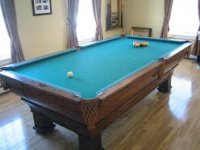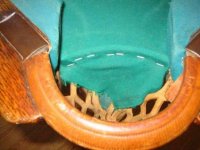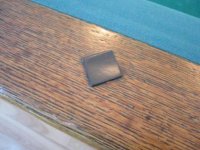Hi all,
First off I wish to thank anyone who has something to offer to this thread in advance for taking there time to reply and contribute. I am new to this forum but have spent the last week pouring over the posts and believe it or not I have looked at nearly everyone.
I have an early 1900s antique Brunswick table that I have owned for about ten years and I haven?t really done a lot of work to it other than what was necessary and setting it up. Near as I can tell this table is very close to a table Brunswick called the Newport but not as ornate. I am not looking to completely restore it as I like the patina and character that it has. However, it does have several playability problems that I would like to address, (probably to the point of affecting my game, don?t we all need an excuse). I have been very tempted to just get a Brunswick Gold Crown or Diamond but have put up with poor playability because I love this table. So, I thought I could ask some questions here.
First off let me tell you a bit about my abilities. I claim to have no experience as a table mechanic but have worked on this one myself and have helped a few of my friends fix problems with their tables also. I am a master auto tech, now working as an engineer and have done carpentry and machining and many other things that have given me some skills and a whole bunch of tools. I have learned a lot from reading this particular forum and a lot of my questions have been answered here already. Table mechanic work certainly seems to be a craft that requires a lot of skill and I certainly respect anyone that has regard for their workmanship in doing this craft. I hope to be able to contribute by detailing my repairs after doing some research and gathering materials so that others may benefit.
The slates:
There are no brass dowel pins between the slates and a couple of the holes are broken out. I am not sure they are necessary as I am able to get these slates dead nuts level using a machinist?s level, machinist?s straight edge and even feeler gauges. Could someone offer an opinion on these pins?
The boards on the back, a couple had come loose and I just used contact cement to glue them back on. I used the contact cement so I wouldn?t be inadvertently shimming the slates with something thicker. Is there a more correct way to do this?
The pocket shelf area has wood? I originally thought this was because the table had been modified in some way but I have seen photos of other tables that had this same treatment. Does anyone know why this would have been done this way? When I first got the table these were all beat up and loose and somebody used plaster to fill in this area. Because nothing looked correct about the dimensions of the pocket shelf I took some measurements off another table and made up some replacements out of plywood then used bondo and planed it to level and smooth this area off. Is there a better way to do this? Can these wood shelves be purchased? The plywood now is just screwed and glued to the backer board and not really attached to the slates. The dimensions of the pocket openings are correct but I cringe everytime a balls bounces in this area.
A table like this has the T-rails so the rails attach to the slates using bolts that thread into what I would call barrel nuts which are installed into holes in the slate. The head rail has a barrel nut that has been broken out of the slate and a chunk of the slate is missing under the rail, (nothing I did). These rails have four bolts and the one that has the problem is on an end. You wouldn?t believe how dead the rail is on a hard hit in this area. I am wondering if the slate can be drilled out further on the slate surface and use a longer bolt threaded into another barrel nut. If this gets into the playing surface how will I deal with the movement of the nut and sealer when tightening down the rail? Can the slate be drilled and is there a special drill bit or just a good masonry bit? I certainly do not want to cause a problem that would break the slate. Is there a supplier for the barrel nut and a longer bolt? As I recall the bolts were a coarser thread than standard 3/8x16 but that does not really matter as the bolt would be longer so would not mix up with the other rail bolts anyhow.
The rails:
The rails are just plain dead and the rubber feels hard so I am quite sure it is time for replacement. I am not sure if the rails were installed incorrectly or if they are the wrong profile but the nose is just over 1.5 inches above the surface of the table. The measure of the table from cushion nose to nose is 50 ?? by 100 3/8?. Could this also be due to the incorrect rails? As I recall the K55 is the correct replacement does anyone have a suggestion for brand and supplier? Artemis may be a bit pricey but I don?t want to put something on there from China perhaps there are some other options. Working with contact cement can be tricky as commitment happens pretty fast. Is there a method someone can recommend for assuring the rubber is straight when it goes onto the sub-rail? I have thought of flipping the rail upside down on the bare slate then sliding the rubber to the sub-rail to ensure it is straight but am not sure is this would work in practical application. Is there any pressure that should be applied after the rail is initially positioned and attached?
The pockets measure 5 1/8? so I am going to shim them using some ?? birch finish plywood I have on hand which will get me close to 4 ?? and want to thank Kingcobra for the detailed posting he did on his methods for doing this. I think he was using something other than what I have seen available in catalogs as standard pocket shims on the rail ends. It looked almost like the red rubber, (easily obtainable in small sheets), plumbers often use for making gaskets. I loved the way these came out can anyone tell me what they use I would love to duplicate what he did. Is there a difference in the hardness of these facings and does that change how well the pocket accepts the ball?
The top of the rails are oak and the rail sights measure 1x1?. I have never seen a replacement sight that size and most are round or diamond shaped but not square. A few of the sights are missing and a couple of the 1x1? pockets have been filled with putty. The pockets for the diamonds look too well cut to not be original but I do wonder if someone just used a piece of chalk to outline the relief because a chalk fits in like a glove. Has anyone seen replacement diamonds this size?
Does anyone have any suggestions on the pockets? The table has the old pocket irons and leather drop pockets. I am sure these have been replaced and just do not look correct. I have just been finishing off the drop area of the pocket as others in the past have I am considering sewing up an apron that would cover this area. Does anyone have a better suggestion?
I am a little embarrased to post photos as I am sure my work doesn?t look up to par but I am looking to improve all of that this time around. The table cloth is 10 year old Simonis 860 and the rail cloth I have never replaced.
Again, Thank You for your time in reading and responding to this post.
If you would like to find the repairs that were done to this table go here.... http://forums.azbilliards.com/showthread.php?t=87941



First off I wish to thank anyone who has something to offer to this thread in advance for taking there time to reply and contribute. I am new to this forum but have spent the last week pouring over the posts and believe it or not I have looked at nearly everyone.
I have an early 1900s antique Brunswick table that I have owned for about ten years and I haven?t really done a lot of work to it other than what was necessary and setting it up. Near as I can tell this table is very close to a table Brunswick called the Newport but not as ornate. I am not looking to completely restore it as I like the patina and character that it has. However, it does have several playability problems that I would like to address, (probably to the point of affecting my game, don?t we all need an excuse). I have been very tempted to just get a Brunswick Gold Crown or Diamond but have put up with poor playability because I love this table. So, I thought I could ask some questions here.
First off let me tell you a bit about my abilities. I claim to have no experience as a table mechanic but have worked on this one myself and have helped a few of my friends fix problems with their tables also. I am a master auto tech, now working as an engineer and have done carpentry and machining and many other things that have given me some skills and a whole bunch of tools. I have learned a lot from reading this particular forum and a lot of my questions have been answered here already. Table mechanic work certainly seems to be a craft that requires a lot of skill and I certainly respect anyone that has regard for their workmanship in doing this craft. I hope to be able to contribute by detailing my repairs after doing some research and gathering materials so that others may benefit.
The slates:
There are no brass dowel pins between the slates and a couple of the holes are broken out. I am not sure they are necessary as I am able to get these slates dead nuts level using a machinist?s level, machinist?s straight edge and even feeler gauges. Could someone offer an opinion on these pins?
The boards on the back, a couple had come loose and I just used contact cement to glue them back on. I used the contact cement so I wouldn?t be inadvertently shimming the slates with something thicker. Is there a more correct way to do this?
The pocket shelf area has wood? I originally thought this was because the table had been modified in some way but I have seen photos of other tables that had this same treatment. Does anyone know why this would have been done this way? When I first got the table these were all beat up and loose and somebody used plaster to fill in this area. Because nothing looked correct about the dimensions of the pocket shelf I took some measurements off another table and made up some replacements out of plywood then used bondo and planed it to level and smooth this area off. Is there a better way to do this? Can these wood shelves be purchased? The plywood now is just screwed and glued to the backer board and not really attached to the slates. The dimensions of the pocket openings are correct but I cringe everytime a balls bounces in this area.
A table like this has the T-rails so the rails attach to the slates using bolts that thread into what I would call barrel nuts which are installed into holes in the slate. The head rail has a barrel nut that has been broken out of the slate and a chunk of the slate is missing under the rail, (nothing I did). These rails have four bolts and the one that has the problem is on an end. You wouldn?t believe how dead the rail is on a hard hit in this area. I am wondering if the slate can be drilled out further on the slate surface and use a longer bolt threaded into another barrel nut. If this gets into the playing surface how will I deal with the movement of the nut and sealer when tightening down the rail? Can the slate be drilled and is there a special drill bit or just a good masonry bit? I certainly do not want to cause a problem that would break the slate. Is there a supplier for the barrel nut and a longer bolt? As I recall the bolts were a coarser thread than standard 3/8x16 but that does not really matter as the bolt would be longer so would not mix up with the other rail bolts anyhow.
The rails:
The rails are just plain dead and the rubber feels hard so I am quite sure it is time for replacement. I am not sure if the rails were installed incorrectly or if they are the wrong profile but the nose is just over 1.5 inches above the surface of the table. The measure of the table from cushion nose to nose is 50 ?? by 100 3/8?. Could this also be due to the incorrect rails? As I recall the K55 is the correct replacement does anyone have a suggestion for brand and supplier? Artemis may be a bit pricey but I don?t want to put something on there from China perhaps there are some other options. Working with contact cement can be tricky as commitment happens pretty fast. Is there a method someone can recommend for assuring the rubber is straight when it goes onto the sub-rail? I have thought of flipping the rail upside down on the bare slate then sliding the rubber to the sub-rail to ensure it is straight but am not sure is this would work in practical application. Is there any pressure that should be applied after the rail is initially positioned and attached?
The pockets measure 5 1/8? so I am going to shim them using some ?? birch finish plywood I have on hand which will get me close to 4 ?? and want to thank Kingcobra for the detailed posting he did on his methods for doing this. I think he was using something other than what I have seen available in catalogs as standard pocket shims on the rail ends. It looked almost like the red rubber, (easily obtainable in small sheets), plumbers often use for making gaskets. I loved the way these came out can anyone tell me what they use I would love to duplicate what he did. Is there a difference in the hardness of these facings and does that change how well the pocket accepts the ball?
The top of the rails are oak and the rail sights measure 1x1?. I have never seen a replacement sight that size and most are round or diamond shaped but not square. A few of the sights are missing and a couple of the 1x1? pockets have been filled with putty. The pockets for the diamonds look too well cut to not be original but I do wonder if someone just used a piece of chalk to outline the relief because a chalk fits in like a glove. Has anyone seen replacement diamonds this size?
Does anyone have any suggestions on the pockets? The table has the old pocket irons and leather drop pockets. I am sure these have been replaced and just do not look correct. I have just been finishing off the drop area of the pocket as others in the past have I am considering sewing up an apron that would cover this area. Does anyone have a better suggestion?
I am a little embarrased to post photos as I am sure my work doesn?t look up to par but I am looking to improve all of that this time around. The table cloth is 10 year old Simonis 860 and the rail cloth I have never replaced.
Again, Thank You for your time in reading and responding to this post.
If you would like to find the repairs that were done to this table go here.... http://forums.azbilliards.com/showthread.php?t=87941




Last edited: